Introduction |
This is a 'A' Level Design & Technology project. At the time when this was done this project was worth 15% of the marks. It helped me get an A grade in 1998. The whole project is reproduced here for your reference. In is an investigation into the method of making extruded plastic floor skirtings. The name of the company has been changed to CompanyX. The name of the product range has been changed to the Purple range. All the names of the people in the company trees have been errased.
|
This is a real A-Level project and as such is intended for educational or research purposes only. Extracts of this project must not be included in any projects that you submit for marking. Doing this could lead to being disqualified from all the subjects that you are taking. You have been warned. |
Contents
- Planning Strategy
- The Company
- CompanyX Extrusions - Company Structure
- The Sales Team
- Sales And Marketing Team Structure
- Marketing Department
- Quality Control Department
- Quality Control And Safety Department Structure
- The Beginning
- The Manufacturing Process
- Extrusion Of The Purple Range
- The Die
- Decorative Foils
- Cutting The Finished Product
- Fitting The Purple Range
- Quality Control
- On Site Testing
- Marketing
- Sales
- Conclusion
I went to CompanyX Extrusions to follow the design process of their recently launched Purple range of floor skirting. I went there to examine what had happened from the original idea to the designing, producing, selling and marketing of the finished product.
Planning Strategy |
I will be going to CompanyX for one afternoon a week for 10 weeks. I plan to spend three afternoons at the extrusion site, two afternoons in the Sales office, two at the marketing department and two afternoons at the storage and packaging department.
By splitting my time up so that I spend different afternoons in the different departments I will be able to see how the company operates as a whole and so get an idea of how the various parts of CompanyX interconnect. I will prepare questions in advance so that I can find out as much information as I need on every visit. I will talk to several people on each visit, hopefully the manager in charge of the section and one of the ordinary employees in the section. This way I will be able to get information on how the area is operated by the management and also how the ordinary employees work in the section. From this I should be able to obtain a balanced view of how CompanyX operates. I will take notes whilst I am at CompanyX and write them up when I got home to ensure that the information is fresh in my memory. From these notes I will be able to prepare a report on the extrusion of the Purple range of floor skirtings.
The Company |
CompanyX makes extruded plastic parts. Most of their products are used in the building industry for stairs and for carpets. The parts are made at K---- Street and then sent to their C---- Street factory where they are packaged and distributed.
CompanyX operates on a three shift rotating pattern from Monday's to Friday. The shifts are from 6.00am - 2.00pm, 2.00pm - 10.00pm and 10.00pm to 6.00am.
CompanyX has it's own tool room, quality control laboratory, die cleaning store and a material recycling facility.
One of their newest products is the Purple range of floor skirting. It consists of a plastic skirting board with the pattern already printed onto it. This makes it easier for the architects and decorators to match the skirting to the decorations. It is also easier because normally a pattern has to be separately applied to the skirting but there is no need for this with the Purple range.
CompanyX do not stock large quantities of each of their products. If a certain product is ordered they just produce a new batch. They are able to do this as each product has a quick turnaround. The product can be quickly made then a few hours later that extruder can be making a totally different product. They have 12 extruders so they can make many different products simultaneously.
Like all of CompanyX's other products the Purple range is made using extrusion. This is where soft plastic is forced through a die to make the right shape
CompanyX Extrusions Company Structure |
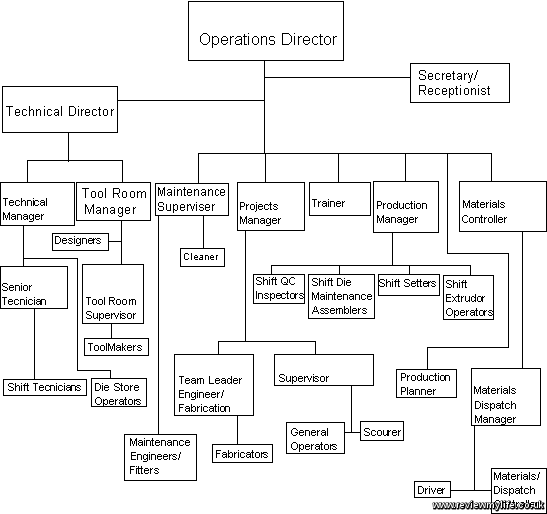
The Sales Team |
The sales team is responsible for collecting the orders from customers and passing them on to the manufacturing department. It provides a service from Monday to Friday. The area managers from the sales team will install their products for customers and also give advice on which product is most suitable for them.
Sales And Marketing Team Structure |
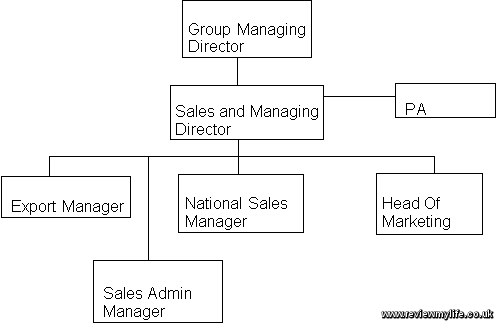
Marketing Department |
The marketing department provides marketing for all the CompanyX products. It is responsible for producing product literature, samples, market research, corporate hospitality and exhibitions to promote it's products.
CompanyX have their own design and printing facilities for any promotional literature.
Quality Control Department |
Some of the bigger CompanyX customers have included the Ministry of Defence and the National Health Service, they have insisted on checking their suppliers such as CompanyX to make sure that the goods being supplied are of good quality. CompanyX therefore had to ensure that they had good quality control procedures in place to satisfy their customers. CompanyX Extrusions have kept their quality standards high and because of this they have obtained the BS 5750 certificate. This certificate confirms to their customers that they have good quality control procedures in place.
Quality Control And Safety Department Structure |
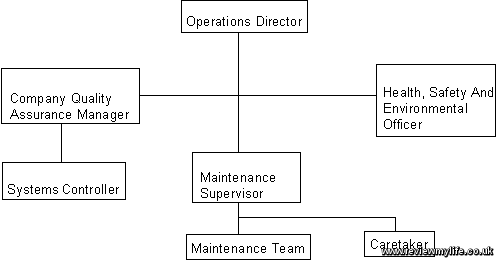
The Beginning |
In 1995 CompanyX noticed that a German company was importing decorative floor skirtings into the country. CompanyX decided to make their own version of it. This was to be different to all their other products as this was the first decorative skirting that they had ever tried to design. They contracted an outside company to do some research into floor skirtings. From this research they had a rough idea of the sort of product they wanted to make. It had to be attractive and functional and be easy to fix onto the wall. There was no formal design process for this product. The design team just made freehand sketches until they came up with a shape that was pleasing to the eye.
CompanyX then had to work out how to get a decorative effect onto the skirting. They got an outside company to try laminating the plastics with the patterns but this proved too costly and it only worked with hard plastics.
They found an English company which had had a lot of success with laminating plastics for small children's toys such as 'Pogs'. CompanyX consulted them and found out that they put their patterns on the toys using heat transferred plastic foils. An American company designed a variety of patterns for them and sold them the finished foils in 170m long rolls.
The Manufacturing Process |
The actual plastic used for the Purple range is PVCP. They buy it in bags of small pellets. These are only about 5mm long to ensure that they can be melted down easily. The pellets are also produced by extrusion. Soft hot plastic is forced through a die containing many circular holes by an extruder. Pellets are cut by a rotating blade which is on the end of the die. There are around 300 colours of plastic pellets available that are made in this way.
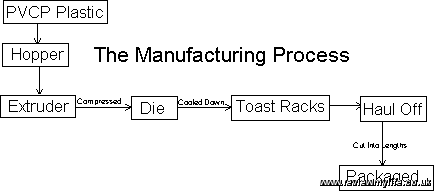
When CompanyX get an order in for an existing product they can very quickly set up all the machines ready to make that product. The most important part in the extruders is the compressive screws which push the plastic through the dies.
Extrusion Of The Purple Range |
To force the plastic through the die they use compressive screws which rotate slowly at about 30 RPM. As they rotate the plastic moves along them. These screws heat the plastic to make it soft. As the plastic moves along the screw it gets compressed due to the thread of the screws getting closer together. The diameter of the screws also decreases so by the time the plastic has reached the end it is very compressed and flows easily through the die.
Each screw is around 1.5m long and is made up of a steel core. The screws used for soft plastics are single screws which have a much shallower thread than those used for harder plastics as they do not need to apply as much force to the softer plastics. The screws for hard plastics are twin screws which have two screws next to each other which rotate in opposite directions.
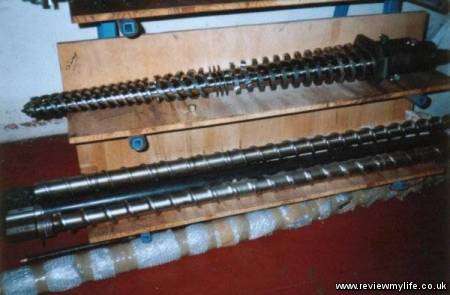
Twin Screw
The compressive screw is housed in a barrel and it is an exact fit to ensure that plastic cannot work it's way back along the barrel. Four metal Micre Bands are placed around the barrel. These bands heat the compressive tube up to around 160 -170 ºC which is sufficient to make the plastic soft and workable.
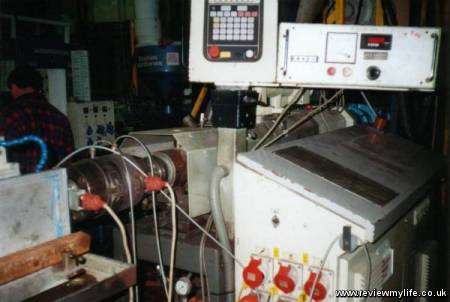
Soft Plastic Screw
The screws consist of four separate zones.
At the thickest end is the Feed-Zone. This is where the plastic pellets drop onto the screws. These pellets are fed into the machine by a hopper which lets the PVCP pellets freely fall onto the screw by gravity. CompanyX also do extrusions with harder plastics, in these machines the pellets are fed onto the screws by a pump.

The hoppers on the extruders are kept continuously filled by a simple suction pump which sucks the pellets from a feeding funnel at the bottom of the machine into the hopper at the top of the machine. This makes it much easier to keep the extruders full of pellets as if they did not have these pumps in place someone would have to climb up about 2 metres of stairs to fill the hopper.

Hopper
After the Feed-Zone the thread of the screw starts to get closer together and so compresses the plastic. This is know as the Compressive Zone. In this zone the amount that the plastic is compressed depends on the type of plastic. Soft plastics such as used in the Purple range are only slightly compressed as they are soft enough to be easily extruded without the extra pressure. The harder plastics are put under a lot of pressure to get the soft enough to go through the die.
The third zone is the Decompressive Zone. This is only present in the screws that are used to extrude hard plastics. In the extrusion process of hard plastics bubbles may build up in the plastic as it is pushed along the screw. If these are not got rid of then this could ruin a whole batch of products. The Decompressive Zone is the area where the bubbles are got rid of. Here the thread of the screw gets wider and so releases the pressure that the plastic was under. The barrel in this area has many small holes in it's surface. The area around this part of the barrel is also under a vacuum which sucks all the air out of the barrel. The plastic is not sucked out as it is not molten enough to get out at this point. It is also no longer under pressure so it will not be forced out of the holes.
In soft plastics, air bubbles are simple able to leave the barrel by flowing up the screw. They therefore do not need a Decompressive zone. Instead at several points along the screw they have jagged edges known as mixers which simply mix the plastic as it passes through them. These mixers make sure that the plastic is of an even composition and make sure that any air is not trapped in the plastic.
The final area of the screw is the Metering Zone. Here the plastic is once again put under pressure as the diameter of the screw narrows to it's smallest point. The plastic is compressed heavily so that it will be able to flow out of the die easily.
The Die |
The dies are custom made by CompanyX for whichever product they are making at the time. They are around 300mm long and have a diameter of about 200mm. In order to function properly they must be at a temperature of about 140 - 150 ºC. If they were fitted cold onto the extruders then it would take about two hours to heat up to the correct temperature which is not acceptable as it is costing CompanyX around £35 per hour to keep their extruders functioning. A few hours before the dies are needed they are taken out of the die room and put in a pre heater which heats them up. When they are needed they are wheeled onto the factory floor and fitted onto the extruder. It then only takes about 25 -30 minutes for them to settle at the right temperature. This period of time is known as the settling down period. This pre heating technique allows CompanyX to get the maximum possible use out of each of their extruders.
Once the plastic has passed through the compressive screw it is soft and is at the right temperature to be extruded. However it is also spinning and so it's motion needs to be altered from spinning round to go straight onto the die. This is achieved by having a breaker plate in-between the screw and the die. This is a metal cylinder around 50mm long which has many small holes in it. When the plastic reaches the cylinder it is forced to go through the holes and so passes in a straight line towards the die.
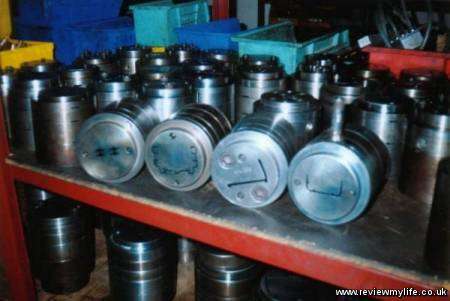
A range of dies that CompanyX can use
The soft plastic goes through the die and is now in the correct shape. It is still molten so it has to be kept in the right shape and cooled down quickly. The plastic passes through a series of toast racks if it is a soft plastic or calibrators if it is a hard plastic. These toast racks or calibrators are exactly the same shape as the original die and so allow the plastic to keep it's shape while it is cooled down.
The hot plastic is drenched in cold water as it passes through these toast racks and the area between each toast rack is under water so the plastic can cool down as quickly as possible.

The calibrators of the hard plastics are almost identical to the toast racks of the hard plastics except that as the plastic passes through the calibrator it is pulled through a vacuum. The calibrators have many small tubes in them that suck the plastic onto them. This helps to make the surface of the plastic as smooth as possible. If there was a tiny scratch in the die then this mark could be passed onto all the plastic that passes through it but the Calibrators help to get rid of these scratches by sucking the plastic into the shape that it is meant to be.
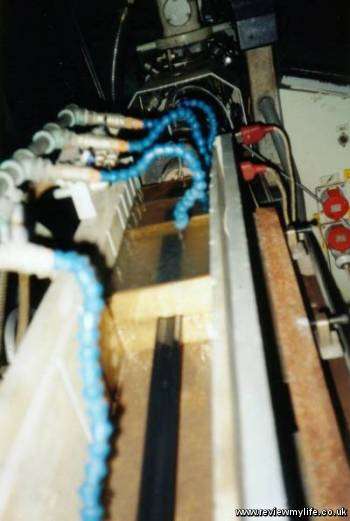
The extruder plastic passing through the toast racks
and being sprayed with water to cool it down
As the plastic passes out of the row of toast racks it is blasted with a jet of pressurised air which blows any water droplets off it. This is very important as any water on the plastic could cause bubbles to form under the decorative foil when it is applied which would result in that batch of products being scrapped.
As the plastic is pushed out of the extruder by the screws it is also pulled off by a separately controlled Haul-Off which consists of two belts which pull the plastic between it. The two machines are separately controlled so this can create problems for the plastic. If it is pulled out much faster than it is being pushed out by the extruder then the plastic will stretch and end up being much thinner than it is supposed to be. If it is pushed out faster than the haul off is pulling it out then it could end up too thick or it could even end up buckling.
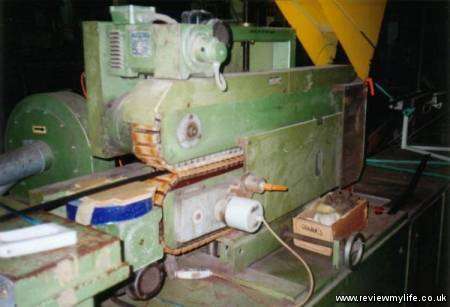
A Haul Off
This can be put to use if the size of the plastic needs adjusting slightly. If they find that the plastic coming out of the machine is too thin they simply slow down the haul off slightly and if the plastic is coming off slightly too thick then they speed up the haul off.
Decorative Foils |
As the plastic skirting passes out of the haul off is goes through the foil heat transfer machine. The plastic passes through a cloth to make sure that it is totally dry. The foil which is slightly too big is rolled onto the plastic and heat is applied to the area where it needs to stick to the skirting. The foil is applied under tension to ensure that it does not buckle or have any bubbles in it. The excess foil is pulled away by another roller leaving just the skirting with the decorative pattern on it.
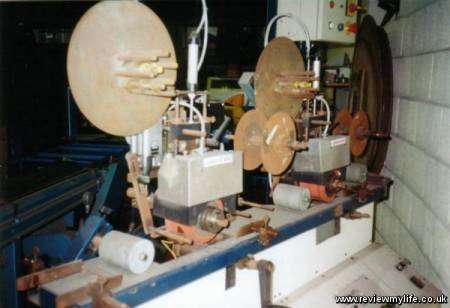
Foil Transfer Machine
Once through the foil transfer machine, a protective plastic film is rolled onto the plastic. The soft plastics are then rolled into rolls by a mechanical roller. Hard plastics cannot be rolled and are therefore cut into lengths of about 2-3 metres by the haul off before being tipped into boxes.
Cutting The Finished Product |
The haul off has a counting mechanism built into it so that once a set amount of plastic has passed through, it guillotines the plastic if it is a soft plastic. The haul offs which are used with hard plastics use a saw to cut the plastic to the correct length.
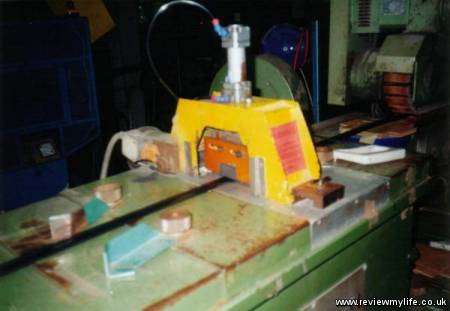
Guillotine
Fitting The Purple Range |
When used in the UK the finished product is designed to be glued onto the walls by using a solvent-based glue. The product is not flat and has a gap but CompanyX recommend applying a lot of glue so that the gap is totally filled. The method of fixing the skirting to the walls is slightly different in the rest of Europe where due to EEC regulations they cannot use solvent based glues. Here a strong form of double sided sticky tape must be used.
Quality Control |
Samples are regularly taken of the products as they come off the extruders. Each product has a specification sheet which details the acceptable error limit. If any of the plastic does not conform to the standards then that batch is scrapped.
The sizes of the plastic are checked with an electronic micrometer. The samples are then taken to a testing room. Here they are cooled to freezing point and a 1kg weight is dropped on the sample from a height of 1m to test the strength of the plastic.
A hand held scanner known as a spectrometer checks the colour of the plastic to make sure it is exactly right. CompanyX buy in their plastic in the colour they want them so if something is wrong with the colour they have to go to the plastic manufactures to find out what is wrong with the colour.
CompanyX make sure that the foil stays on the plastic by using the selotape test. For this a fixed length of ordinary selotape is stuck onto the sample and the ripped off. To pass this test none of the foil should come off with the selotape.
An abrasive test is done to test the strength of the sample. An abrasive wheel is lowered onto the sample with a fixed amount of pressure and is allowed to rotate 200 times. Only a certain amount of plastic is allowed to come off in this test.
To see how the sample ages CompanyX place it in an oven at 60°C. One day in this oven ages the sample by 16 days so they were able to make sure that it could survive for a year easily in less than a month. The Purple range is designed to last five years so that after five years they hope that the companies will have to order a new batch of the product to replace the old skirting.
If a sample fails any of these tests then the whole batch is scrapped. The soft plastics can be sold back to the plastic manufacturers who melt them down and make new plastic pellets out of them but hard plastic have to be sold onto a scrap merchant for a loss.
On Site Testing |
Once the product had passed all these quality control targets it was decided to give it a real life test. In April 1996 CompanyX installed the product at F---- School in M---- and in D---- Hospital. CompanyX installed the skirting in areas such as the canteen in F---- School where they knew it would get a lot of wear. After six months they went back to these places to check the progress of the skirtings. CompanyX found that the product had worn well so they decided to launch it in November 1996.
Marketing |
The marketing department was involved from the start of the manufacture of the Purple range. They had to conduct a survey to find out if there was a need for the product and also to find out what architects might want from a wall skirting. CompanyX pay 'Focus Groups' consisting of architects, designers and distributors to have an open discussion on what they would like to see out of a product. They found that the Purple range would have a good market in modern office buildings and in private hospitals. Once they had found that there was a market for it they could start planning the marketing whilst the production team made the product.
The Purple range is different from most other products as it is "Architect Specified" which means that if an architect is designing a building he may put in that the building is to use Perspective's wall skirtings. As CompanyX are the only people to make this product it means that if they can convince the architects to add this skirting to their designs then they are guaranteed some sales.
The marketing department have the job of making the product known to the industry and the architects. They produce single A4 information sheets that are sent to approximately 5500 distributors and architects which costs them £3700. They also produced more expensive material such as brochures, sample boxes, and 'clapper board' sample cases which are given to serious potential customers. As their sample boxes cost £5 and 'clapper board' sample cases cost £10 they can't afford to give them out to everybody. They had to organise a launch day to which many customers were invited. They also got news of the range into about 20 of the trade journals for which they pay up to £90 for having a photo printed in the editorial.
It costs around £250,000 for them to research and promote a product but it is essential as people can't buy a product if they don't know about it.
Sales |
The sales department is divided into 12 areas, each dealing with a specific area of the country. Each sales person is responsible for all the distributors in his or her area only. CompanyX sell their products to 80-100 main distributors around the country. They prefer not to deal with the builders directly and if they do ring up they are referred to their nearest distributor. The diagram below shows this relationship between CompanyX and it's contractors.
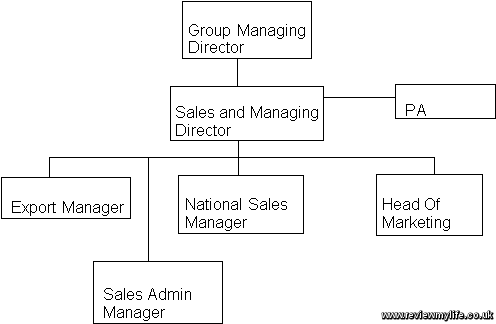
Distributors buy CompanyX goods because they have the largest range of products in the floor and stair edging business. The have an 80% market share in the UK. A lot of their competitors can sell the goods more cheaply than CompanyX, but the greater range of products that CompanyX sell ensures that they should be able to keep their lead in the UK markets for the foreseeable future.
When an order is telephoned in the sales person can quickly call up the details of any of their products or customers from a database. With having the sales people only responsible for a certain area of the country the sales people can quickly get to know the customers and so are able to deal with their orders more efficiently. Once the order has been taken it is sent by an internal network to the factory where the products can either be fetched from the warehouse or a new batch can be made.
CompanyX then store the products till they can be sent to the customer. They have regular delivery of the products throughout the country ranging from every other day for the London area to only once a week for Scotland.
The sales people also are responsible for dealing with any problems or queries that the customers may have about the range of products.
Conclusion |
The Purple range of floor skirtings was launched on the 11th November 1996. I visited them up to June 1997 and only a small amount of The Purple range had been sold. They initially produced a small batch which was worth several thousand pounds but did not sell any of it. This floor skirting now has to be scrapped because the protective plastic on the product starts to deteriorate after six months.
There lack of sales is partly because they have many other products to sell and market so the Purple range gets left out in favour of CompanyX's older but more marketable products. If they do want to sell it they need to have a more effective marketing strategy to make sure that all the architects know about it. It will only be bought if the architects specify a CompanyX floor skirting in their plans so they need to send samples and information out to the architects so that they know what the product is. They have sent samples to distributors but they will not but it unless architects start wanting the Purple range in their designs.
As having a decorative floor skirting is only cosmetic to a building the architects or builders would probably prefer to use the cheaper plain floor skirting in order to cut costs. Therefore it will only be bought for buildings where there is extra money to spend on making the interior look better.
It is also only designed to last 3-4 years which is a factor which will turn a lot of people off this product. People do not want to have to change their floor skirtings every few years, they want them to last for a long time. CompanyX naturally would like companies to buy a new batch of the Purple range every 3-4 years but many of these companies are much more likely to want a harder wearing alternative that needs a lot less maintenance.
They however are not too worried by the lack of orders because with products such as this it usually takes a few years before the orders start to come in. The Purple range is a good idea for a floor skirting and in use looks much more attractive that the usual plain floor skirtings so it is certain to become quite popular in the next few years.
